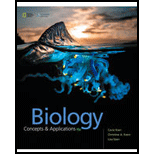
All chordates have (a) _______ as embryos.
| a. backbone | b. jaws | c. notochord | d. kidneys |
Introduction:
Embryo development is a crucial step for ensuring the survival of any species. Initial development is similar for both vertebrates and invertebrates. As the embryo continues to develop, the specific characteristics of the species emerge at different stages.
Answer to Problem 1SA
Correct answer:
All chordates have notochords as embryos. Hence, the correct answer is option c.
Explanation of Solution
Reason for correct answer:
Option c. is given as “notochord.”
As the embryo continues to develop, the ancestral characteristics are seen in the embryo and later specific characteristics of the species emerge at different stages. The nerve cord, notochord, postnatal tail, and pharyngeal slits are the four characteristics that are present in the chordates.
Reason for incorrect answer:
Option a. is given as, “backbone.”
Backbone is the property of vertebrates and all chordates are not vertebrates. So, the embryo of all chordates does not have a backbone. Hence, option a. is incorrect.
Option b. is given as, “jaws.”
Jaws are the characteristic feature of vertebrates and all chordates are not vertebrates. Hence, option b. is incorrect.
Option d. is given as, “kidneys.”
Kidneys are present in vertebral class under vertebrates and it is not the property of invertebrates and chordates include both vertebrate and invertebrates. Hence, option d. is incorrect.
Hence, the options a., b., and d. are incorrect.
The ancestral characteristics are visible during the development of the embryo and the presence of notochord is the characteristic feature of chordates both invertebrates and vertebrates. Thus, the correct option is c.
Want to see more full solutions like this?
Chapter 24 Solutions
BIOLOGY:CONCEPTS+APPL.(LOOSELEAF)
- Echinoderms have _____ symmetry as embryos and _____ symmetry as adults. a. radial; radial c. bilateral; radial b. radial; bilateral d. bilateral; bilateralarrow_forwardEchinoderms have _____. a. triangular symmetry b. radial symmetry c. hexagonal symmetry d. pentaradial symmetryarrow_forwardBoth cartilaginous and bony fishes have______ . a. jaws d. a swim bladder b. a bony skeleton e. a four-chambered heart c. lungs f. all of the abovearrow_forward
- The sister taxon of the Chordata is the _____. a. Mollusca b. Arthropoda c. Ambulacraria d. Rotiferaarrow_forwardMembers of Chondrichthyes differ from members of Osteichthyes by having (a) ________. a. jaw b. bony skeleton c. cartilaginous skeleton d. two sets of paired finsarrow_forwardFlies are_______. a. chelicerates b. hexapods c. arachnids d. crustaceansarrow_forward
- A bird or feathered dinosaur is ________. a. Neornithes b. Archaeopteryx c. Enantiornithes d. Paleognathaearrow_forwardAnimals like annelids and arthropodsetc where the body can be divided intoidentical left and right halves in only one plane, exhibit ________ symmetry.A. Coelenterata B. RadialC. Ctenophora D. Bilateralarrow_forward_______function(s) in the movement of cnidarians. a. A hydrostatic skeleton c. Cnidocytes b. Tube feet d. Malpighian tubulesarrow_forward
- The closest living relatives of hagfishes are_____ . a. snakes c. lampreys b. sharks d. placodermsarrow_forwardAmong living animals, only birds have_____ . a. a cloaca c. feathers b. amniote eggs d. a four-chambered heartarrow_forwardAn animal whose development is marked by radial cleavage and enterocoely is ________. a. a deuterostome b. an annelid or mollusk c. either an acoelomate or eucoelomate d. none of the abovearrow_forward
 Human Anatomy & Physiology (11th Edition)BiologyISBN:9780134580999Author:Elaine N. Marieb, Katja N. HoehnPublisher:PEARSON
Human Anatomy & Physiology (11th Edition)BiologyISBN:9780134580999Author:Elaine N. Marieb, Katja N. HoehnPublisher:PEARSON Biology 2eBiologyISBN:9781947172517Author:Matthew Douglas, Jung Choi, Mary Ann ClarkPublisher:OpenStax
Biology 2eBiologyISBN:9781947172517Author:Matthew Douglas, Jung Choi, Mary Ann ClarkPublisher:OpenStax Anatomy & PhysiologyBiologyISBN:9781259398629Author:McKinley, Michael P., O'loughlin, Valerie Dean, Bidle, Theresa StouterPublisher:Mcgraw Hill Education,
Anatomy & PhysiologyBiologyISBN:9781259398629Author:McKinley, Michael P., O'loughlin, Valerie Dean, Bidle, Theresa StouterPublisher:Mcgraw Hill Education, Molecular Biology of the Cell (Sixth Edition)BiologyISBN:9780815344322Author:Bruce Alberts, Alexander D. Johnson, Julian Lewis, David Morgan, Martin Raff, Keith Roberts, Peter WalterPublisher:W. W. Norton & Company
Molecular Biology of the Cell (Sixth Edition)BiologyISBN:9780815344322Author:Bruce Alberts, Alexander D. Johnson, Julian Lewis, David Morgan, Martin Raff, Keith Roberts, Peter WalterPublisher:W. W. Norton & Company Laboratory Manual For Human Anatomy & PhysiologyBiologyISBN:9781260159363Author:Martin, Terry R., Prentice-craver, CynthiaPublisher:McGraw-Hill Publishing Co.
Laboratory Manual For Human Anatomy & PhysiologyBiologyISBN:9781260159363Author:Martin, Terry R., Prentice-craver, CynthiaPublisher:McGraw-Hill Publishing Co. Inquiry Into Life (16th Edition)BiologyISBN:9781260231700Author:Sylvia S. Mader, Michael WindelspechtPublisher:McGraw Hill Education
Inquiry Into Life (16th Edition)BiologyISBN:9781260231700Author:Sylvia S. Mader, Michael WindelspechtPublisher:McGraw Hill Education





